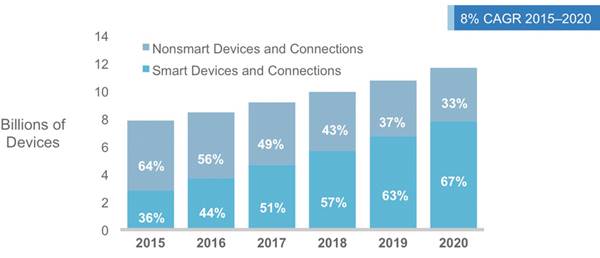As an inveterate marketing technologist, I always love it when the prevailing data trends confirm an intuitive notion of mine. In this case, the notion has to do with the steady rise in mobile video consumption and its associated impact on digital marketing strategy. The prevailing data trend is found in the 2016 edition of Cisco’s annual Visual Networking Index: Global Mobile Data Traffic Forecast Update white paper.
As one might expect from a networking equipment manufacturer, the Cisco Visual Networking Index white paper is chiefly focused on analyzing global mobile data traffic trends insofar as they relate to network infrastructure issues. However, it also provides a number of insights on current and future mobile consumption habits that should pique the interest of anyone engaging in digital marketing.
The Continuing Growth of Mobile (Video)
Here are some key data points that reflect the current state (through 2015) of mobile:
- More than half a billion (563 million) mobile devices and connections were added in 2015. Smartphones accounted for most of that growth. Global mobile devices and connections in 2015 grew to 7.9 billion, up from 7.3 billion in 2014.
- Globally, smart devices represented 36% of the total mobile devices and connections in 2015. (According to Cisco, for the purposes of the study, the term “smart devices” refers to mobile connections that have advanced multimedia/computing capabilities with a minimum of 3G connectivity.)
- In 2015, the number of mobile-connected tablets increased 1.3-fold to 133 million, and each tablet generated 2.8 times more traffic than the average smartphone.
- Mobile video traffic accounted for 55% of total mobile data traffic in 2015. Mobile video traffic now accounts for more than half of all mobile data traffic.
Taken as a whole, these data points paint a familiar picture of an increasingly mobile-centric world where consumers are turning to their smartphones and tablets to watch video with greater frequency and in greater numbers. The figure that jumped out to me was most the 36% smart device penetration among global mobile users—a number which leaves a lot of room for growth in coming years.
Speaking of future growth, here are some nuggets from Cisco’s forecast for the future of the mobile network through 2020:
- The number of mobile-connected devices per capita will reach 1.5 by 2020.
- There will be 6 billion mobile-connected devices by 2020, exceeding the world’s projected population at that time (7.8 billion).
- Globally, 67% of mobile devices will be smart devices by 2020, up from 36% in 2015.
- The total number of smartphones (including phablets) will be nearly 50% of global devices and connections by 2020. (Also, because of increased usage on smartphones, smartphones will cross four-fifths of mobile data traffic by 2020.)
- Three-fourths (75%) of the world’s mobile data traffic will be video by 2020.
- Global mobile data traffic will increase nearly eightfold between 2015 and 2020. Mobile data traffic will grow at a compound annual growth rate (CAGR) of 53% from 2015 to 2020, reaching 30.6 exabytes per month by 2020.

Source: Cisco VNI Mobile, 2016
What it Means for Small Businesses
One sure way to gauge the lasting impact of a marketing trend is to follow the marketing spend. In a blog a few months back, I noted how there is an increasing spate of direct and anecdotal evidence showing the cash flowing into mobile advertising in general and mobile video advertising in particular. Indeed, the steady increase in programmic mobile video ad buying suggests a tacit recognition of the rising importance of mobile video on an institutional level among advertisers and marketers.
To be honest, I’m not particularly concerned with the mobile video adoption curve for large corporations and big advertising and marketing firms; as a rule, such entities have enough in the way of human and monetary resources to capitalize on emerging trends like mobile video in a timely and appropriate manner.
What does concern me is the ability of smaller businesses (and advertising and marketing firms), which represent the vast majority of all companies, to take full advantage of the promise of mobile video. After all, according to U.S. Census Bureau data, 99.7% of US businesses are classified as small businesses (fewer than 500 employees). Moreover, the vast majority of these are what you might classify as “truly small” businesses: fully nine in ten (89.8%) are comprised of fewer than 20 employees.
A lot of these companies don’t have a dedicated team of digital marketers on hand, let alone the requisite video equipment and/or videography professionals on staff to execute mobile-friendly video marketing initiatives. How are they supposed to capitalize on the shift to mobile video?
Happily, there are a number of relatively low-cost to no-cost options at their disposal, ranging from formalized webinars and prearranged online events (i.e. Google Hangouts on Air) to more informal Blab sessions or impromptu promotions via live video streaming apps like Twitter Periscope or Facebook Live.
It’s also worth noting that mobile video is a perfect snackable content medium. For the uninitiated, snackable content is defined as bite-sized nuggets of information that can quickly be consumed, understood, and shared. In my opinion, video blogs, or Vlogs, offer a great (and low-cost) avenue for creating mobile-friendly snackable content. For an illustration, check out this Vlog which talks about non-other than snackable content.
Keep in mind, the key with snackable is to keep it short and sweet. For example, when it comes to snackable video, research from Animoto finds that 83% of consumers prefer videos that are five minutes or less in length.
Marketing Takeaway
As the world continues to go mobile, and smartphone (and tablet) adoption rates continue to rise apace, mobile video marketing will enjoy an ever-greater share of the digital marketing mix. Larger corporations and marketing and advertising agencies already know this and have shifted, or are rapidly shifting, resources into mobile video. Moving forward, smaller businesses cannot afford to ignore the inevitable trend toward mobile video, and will need to adjust their marketing strategies accordingly or face increased marginalization.
(82)







